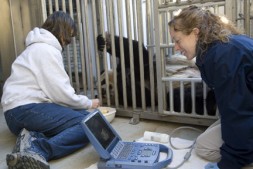Maybe, baby!
A 24-hour pregnancy watch of the National Zoo’s female giant panda, Mei Xiang is slated to begin today at 4 p.m. A corps of more than 40 Friends of the National Zoo volunteers and animal care staff will closely monitor the panda for maternal behaviors through keeper interactions and a series of 38 cameras set up throughout the giant panda habitat. The public can also tune into the National Zoo’s pandacam to track her activities and view a birth should it occur.
FONZ volunteers have undergone hours of training to take part in the around-the-clock watch and have learned to identify and record a variety of Mei Xiang’s behaviors, such as nest building and cradling of small objects. The volunteers will log her behavior both continuously and at five-minute intervals. Recently, volunteer watchers have observed Mei Xiang spending more time shredding bamboo in her den to make a nest.
The watch is being instituted today after Zoo scientists determined that Mei Xiang’s hormone levels are approaching baseline, indicating that the end of her pseudo—or real—pregnancy is near. Within 24 hours of reaching baseline, the world will either see a new cub—or not. Data collected during the pregnancy watch will influence the Zoo’s future management of the species and hopefully result in a greater understanding of the giant panda’s unique and mysterious reproductive biology.
In anticipation of increased traffic to the pandacam, the Zoo will limit each view to five minutes per session. Visitors must refresh their browser to view the webcam again, and they will either return immediately to the cam or, if the site has too much traffic, be asked to try again later.
Get a behind-the-scenes look at how National Zoo scientists analyze panda hormones.
UPDATE: Mei Xiang is not pregnant
Following a final ultrasound and hormone analysis, staff at the National Zoo confirmed late yesterday (Tuesday, April 27) that female giant panda Mei Xiang is not pregnant but was experiencing a pseudo, or false, pregnancy during the past several months.

Zoo staff perform an ultrasound on giant panda Mei Xiang to look for a possible fetus. (Photo by Mehgan Murphy)
National Zoo scientists, veterinarians, keepers and volunteers from the Friends of the National Zoo were keeping a close eye on Mei Xiang, monitoring her hormone levels and behavior, as well as conducting weekly ultrasound exams in an attempt to determine if she was pregnant. On April 22, Mei Xiang’s progestagen concentrations had declined sufficiently to start the 24-hour watch. On reaching normal baseline levels, this decline ends in either the birth of a cub or the end of a pseudopregnancy. Based on current hormone analyses, and not having seen a fetus during the ultrasound exams, Zoo researchers have determined that Mei Xiang experienced a pseudopregnancy.
Female giant pandas almost always undergo a pseudopregnancy when they ovulate but fail to conceive. During a pseudopregnancy, hormonal changes and behaviors are identical to those of a true pregnancy, making it very difficult to determine if a giant panda is actually pregnant or not. This is the fifth time Mei Xiang has had a pseudopregnancy. Giant pandas ovulate only once a year. Mei Xiang gave birth in 2005 to Tai Shan, who was sent to Wolong’s Beifengxia Base in Ya’an, Sichuan, China, in February to join its breeding program.
National Zoo staff expect Mei Xiang to return to normal, hormonally and behaviorally, in the coming days, which includes an increase in appetite and activity level. The Fujifilm Giant Panda Habitat will reopen today at 10 a.m. It had been closed to provide Mei Xiang with a quiet environment in the event that she did give birth.
Giant pandas are endangered; scientists estimate there are around 1,600 remaining in the wild.
Posted: 23 April 2010
-
Categories:
Feature Stories , Science and Nature , Zoo & Conservation Biology Institute




